Rational License Key Server Administration and Reporting Tool
Authors: JaneBalin, MichaelAfsharBuild basis: Collaborative Lifecycle Management 4.0.6 and later, Rational License Key Server 8.1.4 and later
The Rational License Key Server Administration and Reporting Tool provides out-of-the-box license usage reports and capability to download your license usage data into more customizable formats.
The Rational License Key Server Administration and Reporting Tool tracks and reports license usage for IBM Rational products that are served by the FLEXlm Rational Key License Server and the Collaborative Lifecycle Management (CLM) License Server. The tool supports reporting on both floating and token license models.
The tool does not track license usage for Atria licenses and node-locked licenses. The 8.1.4 version of the tool, which was released in August 2013, does not report on CLM Authorized Users, and it does not differentiate between the different CLM role-based licenses: Analyst, Contributor, Developer, Quality Professional, and Stakeholder.
The 8.1.4 version of the tool provides these reports: Peak Usage, User Based, Chargeback, and Token Distribution. Future plans include developing the tool’s capacity to report against CLM Authorized Users, extending the reporting capabilities of the tool to other IBM Rational products that use Jazz Team Server, and eventually making CLM license usage available by user role.

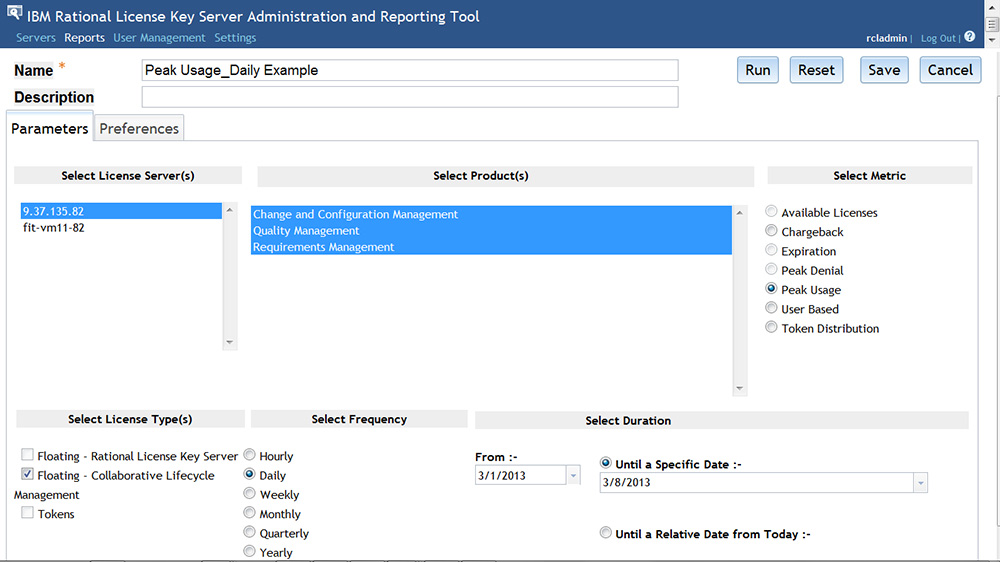
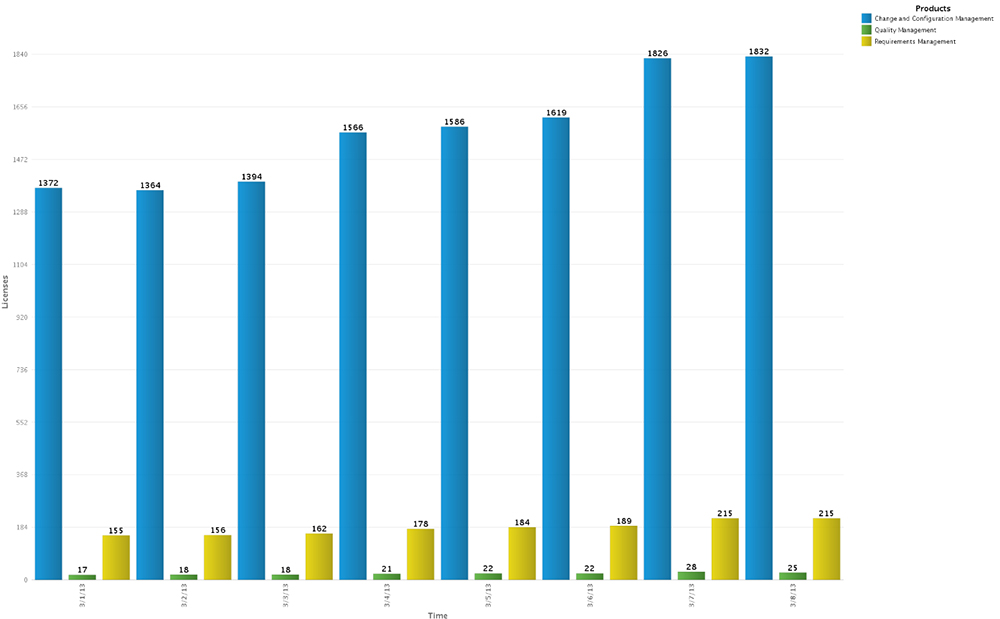
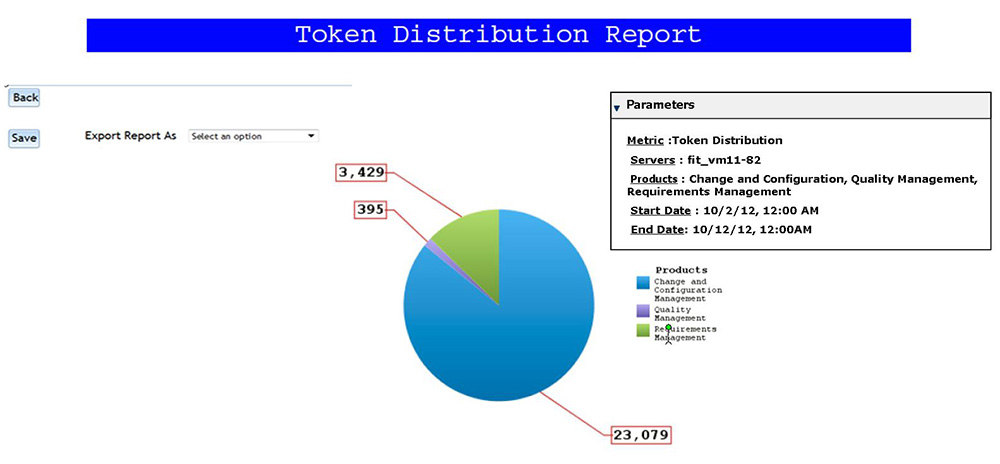
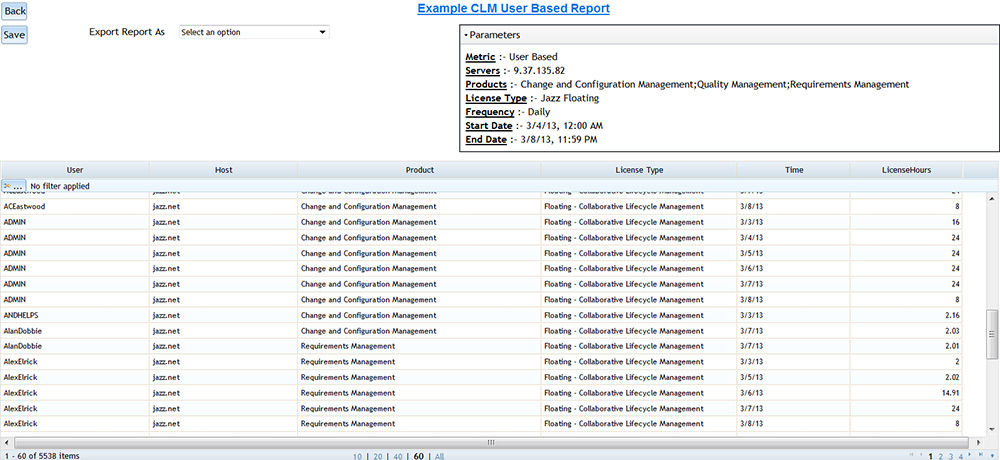
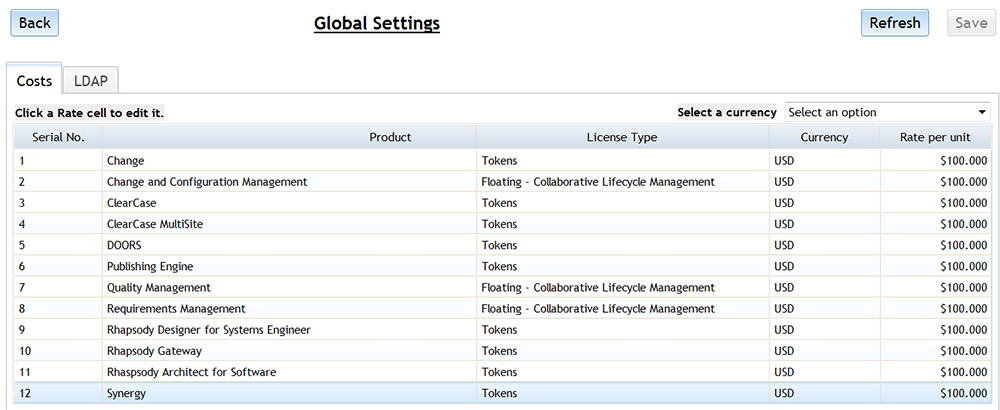 The following chart shows an example of a Chargeback report based on the rate settings noted in the above figure.
The following chart shows an example of a Chargeback report based on the rate settings noted in the above figure.
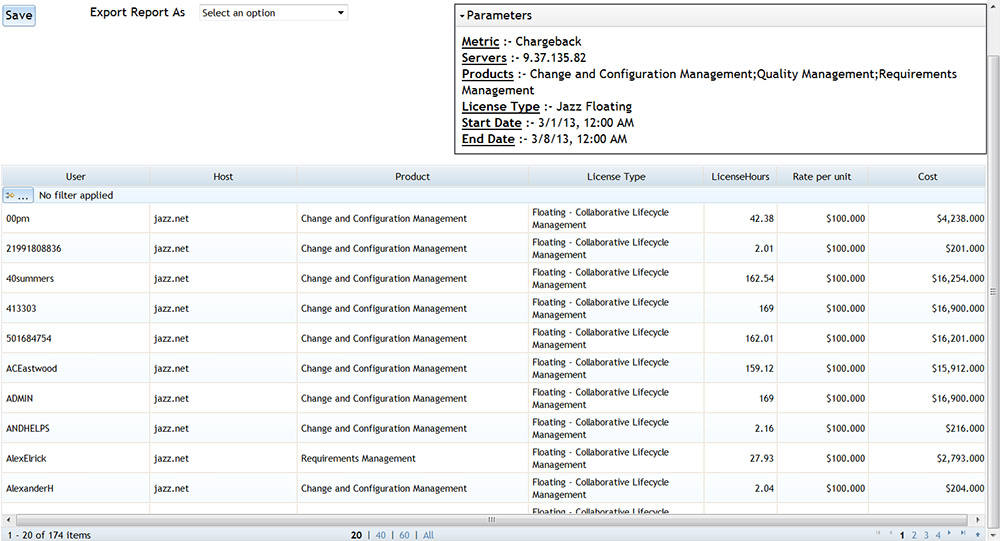
Architecture of the Rational License Key Server Administration and Reporting Tool
The Rational License Key Server Administration and Reporting Tool is a web-based application. The solution is based on a linked data model: the Resource Description Framework. Using a tracked resource set API as an active agent, the tool collects usage data from the FLEXlm and Jazz Team Server logs. The agent converts the log data into Resource Description Framework data, which is stored in a Lifecycle Query Engine (LQE) database. The data is then available to be queried by the tool by using SPARQL Protocol and RDF Query Language (SPARQL). The tool uses IBM Rapidly Adaptive Visualization Engine (RAVE) to render the data into out-of-the-box reports.High-level architecture of reporting

CLM reports: Peak Usage, Token Distribution, User Based, and Chargeback
Peak Usage reports provide details on the maximum usage of product licenses over a given period of time. The following parameters and variables are defined for these reports:- Frequency: How often the data is sampled. Typically customers like to see daily peak usage reports.
- Duration: The period of time over which the customer wants to see the usage data.
- Product: The set of products on which the report is based.
- License types: The various license types for which a report is needed (for example, floating or tokens). The report indicates the count of licenses, which is a sum of the selected types.
- License servers: Users can select the license servers to report against. The report indicates the highest number of licenses used for each selected product from across the specified license servers.
Peak Usage report
With Peak Usage reports, a license administrator can identify usage patterns and thereby reduce license procurement costs. The following examples show a Peak Usage report definition and a chart of the Peak Usage report definition results.Example: Peak Usage report definition

Example: Peak Usage report

Token Distribution report
Token Distribution reports show the usage of tokens across products. This report is based on the total number of tokens consumed across a specified set of products for a selected period of time.Example: Token Distribution report

User Based report
User Based reports give information on the duration that product licenses are used by a defined set of users. The License Hours column data shown in the following example of a User Based report is determined by multiplying the number of specific product licenses that a user has checked out by the total amount of time the licenses were checked out, and then dividing by 60. For example, if a user has checked out two licenses for a specific product and has kept each license checked out for a total of 90 minutes, the license hour calculation would be the following: (2 x 90)/60 = 3.00 license hours. The aggregation of the license usage data per product, per user is advantageous because it results in less data to store in the LQE database.Example: User Based report

Chargeback report
Chargeback reports associate license consumption with cost. A license administrator can charge different departments in the organization for the licenses that they consume. The Chargeback report enables organizations to move to an environment in which licenses are consumed and paid for on a pay-per-use basis. The rate per product for Chargeback reports is defined in the Costs section of the Settings tab in the Rational License Key Server Administration and Reporting Tool. In the following example, the rates per product are set to $100.00 per license hour (see the previous discussion of User Based reports for the definition of license hours). The following chart shows an example of a Chargeback report based on the rate settings noted in the above figure.
The following chart shows an example of a Chargeback report based on the rate settings noted in the above figure.
Example: Chargeback report

Other capabilities
The Rational License Key Server Administration and Reporting Tool also provides the capability to schedule reports and save the scheduled reports. Future plans for the tool include the ability to email scheduled reports. The tool also includes a feature that enables the export of license usage data from saved reports into commonly used formats such as PDF, XML, JSON, CSV, and TSV. This capability enables administrators to create custom reports and to provide license consumption data to other reporting tools, including Microsoft Excel, for further customization. Finally, the user-management side of the tool enables integration with two types of user realms or databases that store user account details: Apache Tomcat and LDAP. This functionality is employed for validating user access and access privileges to the tool. By default, a predefined set of users are created during the installation. The user IDs, passwords, and access privileges are as follows:| User ID | Password | Role description |
|---|---|---|
rcladmin |
rcladmin |
Administrator privileges are assigned to this user with access to all the features of the application. |
rclreportinguser |
rclreportinguser |
User privileges are assigned to this user with access to the reporting feature of the application. |
Downloading, installing, and system requirements
To download and install the tool, see the Rational License Key Server 8.1.4 Download Document. You do not need to download the Rational License Key Server 8.1.4 to download and use the administration and reporting tool. As long as you are at version 4.0.1 or later of the CLM server, you can download, install, and configure the components that are associated with the tool (which the download document specifies) and you can start reporting on CLM license usage. Note: Although not a requirement, if you are using tokens for your CLM products, you might want to download and install the 8.1.4 version of the Rational License Key Server, because it has the most up-to-date defect fixes for serving CLM tokens. As long as your Rational License Key Server for serving CLM tokens is at version 8.1.2 or later, you can use the administration and reporting tool to report on token usage.External links:
- Rational Common Licensing Information Center
- Rational Common Licensing Support Community
- Release notes for version 8.1.4
- Best practices on deployment of IBM Rational License key server(RLKS) on Linux and Unix servers
Youtube videos:
- Getting Started with Rational License Key Server Administration and Reporting Tool, v8.1.4
- Installing Rational License Key Server Administration and Reporting Tool v8.1.4
Additional contributors: AmyLaird, RosaNaranjo
Contributions are governed by our Terms of Use. Please read the following disclaimer.
Dashboards and work items are no longer publicly available, so some links may be invalid. We now provide similar information through other means. Learn more here.